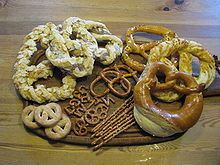Bretzel
A pretzel, pretzel, or salty wrap is a type of cracker or baked bun, and twisted into a bow, with a slightly salty taste. Its origin is in Germany, and it is quite popular in German-speaking Switzerland, Austria, Alsace (France) and North America.
Etymology
Its name comes from the German word Brezel or Breze, derived from the Latin bracellus, 'little arm'. This name is due to the fact that its shape is reminiscent of two intertwined arms. In Germany and especially in Bavaria, the place of its birth, the pretzel is very different from the one in the United States. It is part of the typical food of the country and is a type of salty bread.
Bretzel receives other names: in Old High German brezzila, a word that derived from bretzel, brezl and even pretzel; in Bavaria and Austria Breze or Bretzel, in Viennese speech also Pretzel, in the Swabian dialect Bretzet or Bretzg / Bretzga (sing. / pl.), in Baden and Alemannic often Bretschl; in northern Alsace usually Bredschdel or Bradschdal, in some forms of the Swiss-German dialect set 'Bretzel'.
There are basically two categories: cracker bretzels and soft bread bretzels. The second type can be prepared with a wide variety of flavors, including almond, garlic, etc.
Ingredients
Its main ingredients are usually: wheat flour with yeast, milk and butter.
The dough is briefly dipped in a 3% baking soda solution before baking, and salt is usually added, although sweets, flavored with cinnamon, vanilla, etc., are also made. Some regional recipes also add egg and lemon zest.
History
Its origin seems to be related to the Celtic festivities that were celebrated at the beginning of spring, when the sun passes through the constellation of Aries, the ram, so its characteristic shape would represent the horns of this zodiac animal.
The Romans called them panis tordus. Around 610, the Benedictine monks of Burgundy and the Rhineland adopted them as prizes for children doing their homework. They explained that the "brezel" They represented the arms of a child making his prayers and were called brachiola or pretiola.
Its oldest representation appears in the Hortus Deliciarum The Garden of Earthly Delights, which dates from 1190. In one of the miniatures of the codex there is a scene of a banquet in which Queen Esther and her husband the Persian King Ahasuerus/Xerxes participate. On the table, there is a brezel to the right of the king.
In the Catholic tradition of southern Germany, "palmbrezel" to decorate the palms that were taken to bless the church on Palm Sunday (Palmsonntag).
Contenido relacionado
Tolosa (Guipuzcoa)
Food additive
Beer




